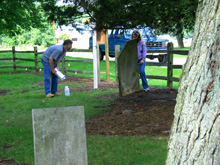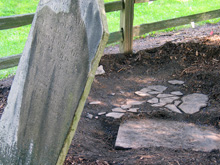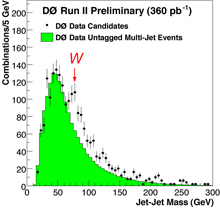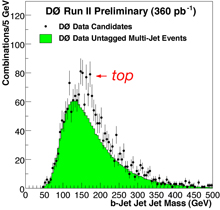 | Thursday, September 28, 2006 |
|
Thursday, September 28
Friday, September 29 Click here for a full calendar with links to additional information. |
|
Extended Forecast |
Secon Level 3 |
|
Thursday, September 28 -Tomato Florentine -Grilled Chicken Cordon Bleu Sandwich -Chimichangas -Smart Cuisine Chicken Marsala -Smoked Turkey Melt -Assorted Slice Pizza -SW Chicken Salad w/Roasted Corn Salsa |
|
Thursday, September 28 Dinner -Coquille St. Jacque -Beef Kabob w/Vegetables -Puree of Potatoes and Celery Root -Rice Pilaf -Pecan Torte w/Bourbon Cream
Wednesday, October 4 |
| Fermilab Today is online at: http://www.fnal.gov/today/ Send comments and suggestions to today@fnal.gov Fermilab Today archive Hurricane Relief Page Fermilab Today PDF Version Fermilab Result of the Week archive Fermilab Safety Tip of the Week archive Linear Collider News archive Fermilab Today classifieds Subscribe/Unsubscribe to |
| New grave unearthed at Fermilab's Pioneer Cemetery | ||
| ||
|
Discoveries are a feature of Fermilab, but rarely do they take the shape of a headstone. During a recent restoration of Fermilab's Pioneer Cemetery, volunteers repaired and reset grave markers, and made an effort to locate unmarked graves.
Adam Rea of Batavia organized the workday for his Eagle Scout project. Fellow Scout Kevin Millen was working near a burial site, probing the ground, when he found a fallen headstone, hidden beneath mulch. "It was really cool," Millen said. "It's not every day you get to find a new grave." During the next week, Geoff Eargle and Katie Kosirog, ES&H, and Bob Lootens, Roads & Grounds, pieced together the inscription. They found "Joel Howe, Age 69" but were unable to make out all of the stone. Searching for clues, they examined a nearby grave, weathered to near illegibility. Eargle poured water over the stone. The sheen cleared some of the letters: "Noah Sabinah: Son of Joel S. and Sally Howe." Joel Howe's grave is part of a family plot; he is buried next to his son. Rea has designed and built a new "Pioneer Cemetery" sign, which includes a directory of the gravesites. Fermilab's cemetery records, last drawn up in 1967, will be updated to include all known graves and epitaphs.
Rea's project attracted the attention of John Heider, a graveyard enthusiast from Monticello, Ill. who drove to Fermilab to aid the group with materials and expertise. He commented, "Locating all the unmarked graves in the cemetery might be compared to what Fermilab does. We know something is there, we look for it, find it, and then becomes part of our daily lives. On Saturday we found pioneers who, 150 years ago, walked on and worked this earth. Fermi is definitely a place of discovery."
|
||
 |
||
| Geoff Eargle and Katie Kosirog puzzle over the inscription on Noah Sabinah's epitaph. |
|
Wired, September 26: Moving Beyond String Theory Ask any credentialed nerd what the ultimate theory of physics is, and chances are they'll reply, "string theory." In string theory -- an idea that's been around since the late 1970s -- the universe is a 10-dimensional place, with six of those dimensions curled up inside themselves like a cat in front of a fireplace. All particles and forces are different resonances and vibrations of these 10-dimensional strings. Strings are far from the only game in town. There are other, potentially equally promising approaches to unifying physics' two seemingly incompatible visions of the cosmos: general relativity and quantum mechanics.
This fall, Columbia University mathematician Peter Woit has published a critique of string theory (Not Even Wrong: The Failure of String Theory), pointing out that in more than three decades, string theory still has yet to make a single prediction that can be verified in the lab or through the lens of a telescope. If all scientific disciplines maintained such fluffy and forgiving standards, Woit argues, science would devolve into little more than medieval disputations about angels and heads of pins.
|
|
Digging down to the top (quark) |
|
|
When looking for top quarks at the Tevatron, most physicists start by looking for at least one high-energy electron or muon in each event. Because there are only a few ways to produce such events, this approach removes a large fraction of the "background" events that do not contain top quarks. However, DZero also likes to search for top quarks the hard way, by ignoring the high-energy leptons and studying top/anti-top quarks in their decay channel to six quarks. These quarks produce collimated sprays of particles called jets that are measured with the DZero detector. On the other hand, nearly everything that happens at the Tevatron results in the production of jets, and the sample of events with six jets is swamped by processes other than top decay.
Recently, the DZero collaboration has measured a very striking top-quark signal in the six-jet channel. Top quarks decay into a bottom quark (b) and a W boson that can decay into two more quarks. In this analysis, two jets were identified as having arisen from b quarks, and the W bosons were directly reconstructed from pairs of jets. The result (Figure 1) was an enhancement at the W mass (80 GeV). These W bosons were then combined with the b jets to reconstruct the top quarks (Figure 2) resulting in a similar enhancement at the top mass (~172 GeV). Background distributions were extracted from data rather than from the Monte Carlo simulations used in other top-quark analyses, providing a natural cross check for DZero top quark measurements. This analysis fills in an important gap in top quark physics at DZero and allows further constraints on top quark properties, such as the mass and production rate. Michael Begel (University of Rochester) is the principal author of this analysis. | |
 |
|
These results rely on a precise understanding of the energy of hadronic jets in the DZero calorimeter. The team above is working to ensure that future DZero analyses will profit from improved jet energy resolutions and a more precise
understanding of the jet energy scale.
| Result of the Week Archive
|
|
|
September 25 - 27 - One store provided 11 hours and 31 minutes of luminosity - TeV suffers from quenches and aborts - Antiproton target repaired - TeV kicker magnet replacement begins 9/28/06 Read the Current Accelerator Update Read the Early Bird Report View the Tevatron Luminosity Charts |
|
Submit Intent Applications for Employee Art Show by October 4 The employee art show is coming up soon, now's the time to submit a letter of intent to enter. Any current or retired employee, contractor, user or relative of an employee is invited to enter. Read more about the show, and find an application, on the gallery's website.
SciTech Dino Auction |


